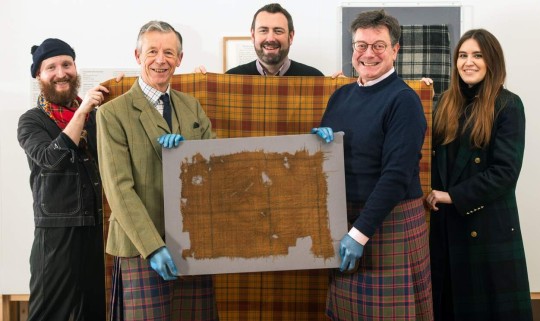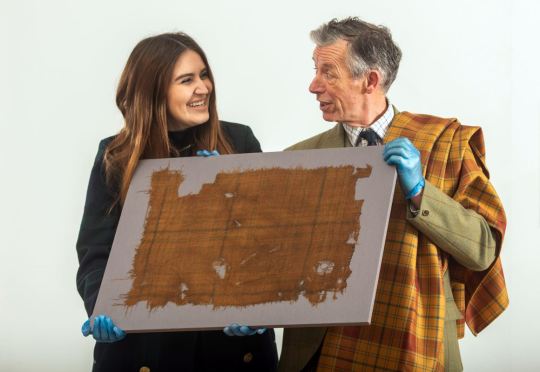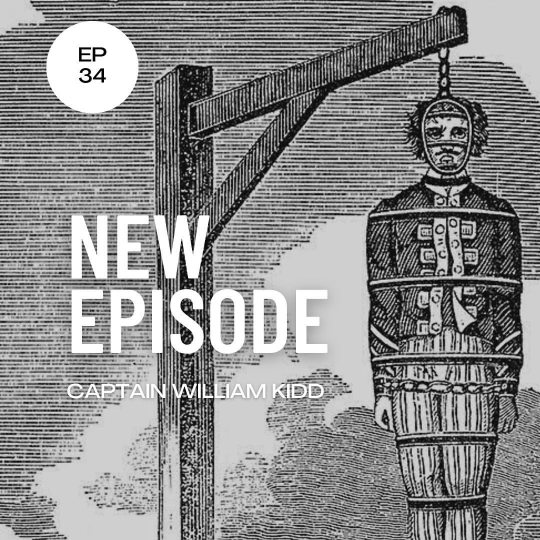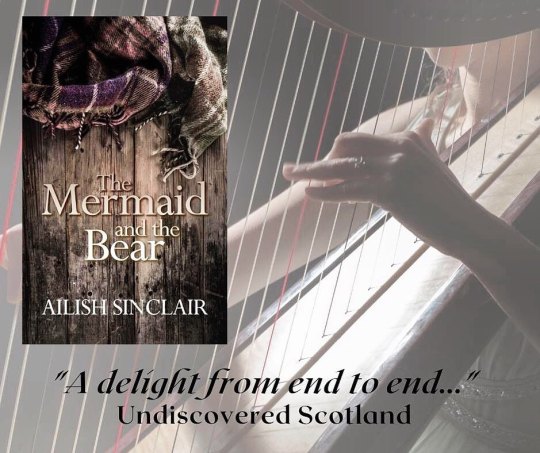#scottishhistory
Text
“A 16th c. Scottish Plaid was Found in a Bog–Now Becomes Oldest Historical Tartan Available to Wear Today”


A textile manufacturer in Scotland has recreated the oldest-known piece of Scottish tartan ever found, which was buried for centuries.
Discovered approximately forty years ago in a peat bog, the Glen Affric Tartan underwent testing organized by The Scottish Tartans Authority last year to confirm it was the oldest surviving piece of tartan, dating back to between 1500-1600 CE.
15K notes
·
View notes
Photo

The Dule Tree beside Leith Hall in Aberdeenshire. A place of mourning and, perhaps at some point, a gallows. #ThickTrunkTuesday #folklore #Scotland #trees #oldtrees #aberdeenshire #history #scottishhistory (at Leith Hall Gardens & Estate) https://www.instagram.com/p/CrcsOHIIlWv/?igshid=NGJjMDIxMWI=
4 notes
·
View notes
Video
youtube
A Scottish Murder Love Triangle - Frightful Fridays
News of the Times Episode 281 | 1765
1765 County Forfar Scotland and 21 year old newly married Katharine Nairn, wed to 40ish bookish Thomas Ogilvie, is the topic of gossip within the household and the community. Dashing younger brother Lieutenant Patrick Ogilvie has arrived back from East India and a warm, and some say, intimate relationship has quickly developed between Katharine and Patrick.
A dangerous game as any kind of relationship between the two would legally be termed incestuous with severe penalties involved. As the relationship grows, Patrick is banished from the house.
A plan is hatched between the two lovers that would not only allow them to be together but also enable Patrick to be the new Laird with title and inheritance. But waiting in the wings is the partner of the third brother watching, spying and reporting. With both brothers gone, the youngest brother would become sole inheritor and the new Laird.
A salacious, tangled love triangle that turned to murder from Scotland 1765 is today’s episode of Frightful Fridays. We hope you enjoy the show! Hosted by Robin Coles.
#youtube#scotland#scottishhistory#historicaltruecrime#historicalcrimedocumentary#victorianmurders#historicalcrimestories#victoriancrimestorie#victoriancrimestories#newsofthetimes
1 note
·
View note
Text
Unraveling the Legacy of Clan MacDonald: A Historic Journey

Embark on a journey through time as we delve into the rich heritage of Clan MacDonald. From the rugged landscapes of the Scottish Highlands to the tales of legendary warriors, Clan MacDonald has left an indelible mark on Scottish history. Explore the traditions, customs, and stories that have shaped this illustrious clan for generations. Join us as we unravel the legacy of Clan MacDonald and discover the enduring spirit of one of Scotland's most iconic clans.
Ready to dive in? Click the link below to explore more at Tartan Vibes Clothing!
📌 Read now: https://www.tartanvibesclothing.com/blogs/history/clan-macdonald
Website: https://www.tartanvibesclothing.com/
#ClanMacDonald#ScottishHeritage#HighlandHistory#ScottishHistory#TartanVibesClothing#tartanvibesclothing#scottish#tartans#clan#pattern#plaid#scotland#scottishheritage
0 notes
Text
You are in the middle of the Battle of Bannockburn (1314 CE)
As you find yourself in the midst of the Battle of Bannockburn in 1314 CE, the context is one of intense conflict between the Kingdom of Scotland, led by King Robert the Bruce, and the Kingdom of England, under the rule of King Edward II. The battle takes place near the town of Bannockburn, situated in central Scotland.
Both sides have gathered their armies for what will become a monumental…

View On WordPress
#14thcentury#Bannockburn#BattleofBannockburn#bravery#England#Englisharmy#Historicalbattle#KingEdwardII#KingRoberttheBruce#Military#resilience#Scotland#Scottishculture#Scottishforces#Scottishfreedom#Scottishhistory#Scottishindependence#Scottishpride#Strategicacumen#TurningPoint#Warfare
0 notes
Text
Could one rare plant hold the key to a thousand riches?
PlotÈ l’estate del 1822 ed Edimburgo è in fermento per le voci sull’imminente visita di Re Giorgio IV. Nei circoli botanici, tuttavia, un altro tipo di eccitazione ha attanagliato la città. Nel giardino botanico appena inaugurato, la pianta di Agave Americana sembra destinata a fiorire, un evento che si verifica solo una volta ogni trent’anni.Quando Elizabeth, appena rimasta vedova, arriva a…

View On WordPress
0 notes
Text
Britches or Breeches: Scottish Fiddle Tunes
By: Lisa Timmerman, Executive Director
“Leather breeches full of stitches,
Old shoes and stockings on--
My wife she kicked me out of bed
Because I had my breeches on.”
When the Scottish and Scots-Irish arrived in Virginia, they spread across the state attracted to the different environments and landscapes. While Dumfries certainly experienced an influx of Scottish, immigrants also went to the Appalachian frontier. What excites us is how the immigrants weaved their heritage, experiences, and memories of their homelands into our state. One way we can see the influence is by listening to folk music.
While Parson Weems famously fiddled, he was not the only Scotsman with the taste for this instrument. The fiddle arrived in North America during the 17th century and quickly became popular due to the lightweight and portable nature of the instrument along with its’ versatile tunes. The fiddle provided the perfect atmosphere for joviality, especially among those who faced long and arduous days laboring for basic daily needs, such as food, and the chance to participate in the local economy. Virginia even held fiddle contests in the early 18th century, colonial Americans even seeking experienced indentured and enslaved persons for their performances. Of course, fiddling evolved into its’ own unique style in different Virginia regions, incorporating cultural elements from free black persons, enslaved persons, Italian immigrants, and German immigrants to name a few. Dancing quickly became a part of the fiddle performance along with the banjo, the two instruments gaining popularity in the late 19th century.

(Reed, Henry, Bobbie Thompson, and Katherine B Olson. Henry Reed playing the fiddle, accompanied by Bobbie Thompson of the Hollow Rock String Band on guitar, at the Narrows Virginia Fiddlers Contest, summer. United States Narrows Virginia, 1967. Summer. Photograph. https://www.loc.gov/item/afcreedp.17/)
Famous Virginia fiddler Henry Reed (1884-1968), performed one musical piece that highlights the Scottish and American cultural influences. “Leather Britches” probably evolved from a late 16th century Scottish reel known as Lord MacDonald’s Reel, although Professor Samuel Bayard noted it was either related or connected to popular Irish tunes, such as “Breeches On (The)”, “Irish Lad (The),” “Irish Lad’s a Jolly Boy”, and “O the Breeches Full of Stitches.” Researcher and fiddler Lisa Ornstein collected scant evidence to support this citing a 1879 book referencing breeches and stitches. Once the tune arrived in America, it quickly spread into and past Virginia with interesting changes. First, the title. “Leather Breeches” could refer to the green snap beans dried in their pods. To dry them, people pierced the pod with a needle, stringing them to hang. The other possible meaning is the actual leather garment. Some musicians have noticed that playing the fiddle invokes a similar motion to sewing leather with a needle and thread. These different meanings have also influenced the different ballads. The following are examples of other verses, from both oral and print historical sources:
“Leather breeches, full of stitches,
Mammy sewed the buttons on.”
“Leather Breeches full of stitches,
Leather Breeches, Leather Breeches;
Mammy cut 'em out an'
M'daddy sewed an' sewed the stitches.”
Despite some ministers from the 18th century deeming the fiddle as a “devil’s box,” the fiddle and this tune remain popular to this day, especially in fiddling contests performed across America. As with folk tales and folklore, folk music helps retain collective memories and can document the shift in people’s ideologies and tastes. If you ever find yourself at a tavern with a fiddler, listen carefully to the words and melody as you enjoy the vibrant living lore of America.
Note: Ready for more folklore? Join our virtual Weems-Botts Bibliophiles in April where we read short Arthurian Legends and discuss the rich historic and literary history behind them! Click here for your ticket to Camelot.
(Sources: The Library of Congress: Digital Collections: Fiddle Tunes of the Old Frontier: The Henry Reed Collection: Articles and Essays: The Historical and Cultural Significance of Fiddle Tunes of the Old Frontier, https://www.loc.gov/collections/henry-reed-fiddle-tunes/articles-and-essays/the-historical-and-cultural-significance-of-fiddle-tunes-of-the-old-frontier/; Olson, Ted. 2017. Scottish Culture: Scottish and Scots-Irish Music. The Crooked Road's Mountains of Music Homecoming: The Official Homecoming Guide. 32. http://mtnsofmusic.com/wp-content/uploads/2017/04/MOMH_ProgramGuide_FINAL-lowres.pdf; The Traditional Tune Archive: The Semantic Index of North American, British, and Irish: Leather Britches, https://tunearch.org/wiki/Annotation:Leather_Britches; National Park Service: Blue Ridge: The Fiddle; Craft Revival: Shaping Westwern North Carolina Past and Present, (Project of Hunter Library Digital Initiatives at Western Carolina University, Velde, Patrick. Instruments: Fiddle, https://www.wcu.edu/library/DigitalCollections/CraftRevival/crafts/fiddle.html)
#localhistory#folkmusic#folktunes#fiddle#community#folklore#scottishhistory#musicalhistory#virginiahistory
0 notes
Photo

It's #FindOutFriday again! How did you fare on the topics of child marriage, escaping, King George IV of England and David Ricco? Answers are here: https://www.saraelliemackenzie.com/post/findoutfriday-answers-5 #TriviaAnswers #FiveIsWayTooMany #BasedOnFacts #TruthIsStrangerThanFiction #MarriedTooYoung #ChildBride #MarriedToAnOlderMan #ScalingWalls #BerlinWall #DontLiveLikeARefugee #Hanovarian #GermanLine #GreatBritain #MaryQueenOfScots #ScottishHistory #Italian #HistoricalDrama #HistoryInFiction https://www.instagram.com/p/CpDHj2qLnzY/?igshid=NGJjMDIxMWI=
#findoutfriday#triviaanswers#fiveiswaytoomany#basedonfacts#truthisstrangerthanfiction#marriedtooyoung#childbride#marriedtoanolderman#scalingwalls#berlinwall#dontlivelikearefugee#hanovarian#germanline#greatbritain#maryqueenofscots#scottishhistory#italian#historicaldrama#historyinfiction
0 notes
Photo

Episode 34 is out now! Captain William Kidd, a Scottish privateer turned pirate, was the inspiration for Robert Louis Stevenson’s swashbuckling novel Treasure Island 🦜🏴☠️ Stream this episode wherever you get podcasts. #podcast #scottishhistory #scotland (at Scotland) https://www.instagram.com/p/CoHLvtuMBRK/?igshid=NGJjMDIxMWI=
0 notes
Photo

Part three is up #scottishwitchtrials #scottishhistory #northberwickwitchtrials https://www.instagram.com/p/Ck8mlpQoBHs/?igshid=NGJjMDIxMWI=
0 notes
Photo

The second novel in the celebrated Outlander series is set twenty years after the events of the first book. It follows Claire Randall who has kept so many secrets of her life with Highlander Jamie Fraser in the 18th century and with her grown daughter in tow, returns to modern day Scotland. The narrative follows Claire as she takes her daughter, Brianna to see an academic, Roger who promises to help them find out what may have happened to Jamie all those centuries ago. As Claire comes clean and tells Brianna the truth about her past the reader is taken back to the infamous court of Charles Edward Stuart as she and Jamie try to prevent an uprising with Bonnie Prince Charlie at the helm that leads to the loss of just over a thousand men on the Culloden battlefield. Although this is a chunky book, it’s well worth the effort, especially if you’re a fan of detailed historical fiction. As expected from the point of view of my own preferences, I preferred the story set in the past and loved how embroiled both Claire and Jamie became within the royal court. I have to admit, the character of Brianna, Claire’s daughter grated a little bit on me, she came off as slightly brattish - I can only hope she becomes more sympathetic or at least grows on me in the books to follow. However, I was completely captivated by everything else, particularly in the trials that Claire and Jamie face as a couple. This is a great series to get absolutely lost in and it’s obvious that the author has done her homework in terms of historical detailing. Dragonfly In Amber is a sweeping, beautiful love song to Scotland, past and present and I can’t wait to get stuck into the next novel in the series, Voyager. Four solid stars 🌟 🌟 🌟 🌟 #bookstagram #scottishbookstagrammers #outlanderseries #dragonflyinamber #dianagabaldon #bookssetinscotland #historicalfiction #scottishhistory #scottishbooksta #scotlandhasstolenmyheart #18thcenturyscotland #claireandjamiefraser #recommendedreads👍 https://www.instagram.com/p/Ci8RfzXLNAI/?igshid=NGJjMDIxMWI=
#bookstagram#scottishbookstagrammers#outlanderseries#dragonflyinamber#dianagabaldon#bookssetinscotland#historicalfiction#scottishhistory#scottishbooksta#scotlandhasstolenmyheart#18thcenturyscotland#claireandjamiefraser#recommendedreads👍
1 note
·
View note
Text
Healing Wells and Fairy Trees

Healing wells, which are springs or small pools of water thought to be magical, have a long history of tradition that dates back to pagan times.
“In pagan times, wells and springs were believed to be inhabited by a spirit or divinity, who caused the waters to have healing properties to those who drank of them or bathed in them, at the same time propitiating the divinity with an offering.”
“The misty isle of Skye : Its scenery, It’s people, Its story” by Eneas Mackay, Stirling, (1927)

I am going to try to cover the basics of them as quick as possible, so please bear with me if I skip bits as I try to keep this post a reasonable length. If I miss a fact you love, please share it for everyone to read.
“Wherever there was a spring, there was life; where-ever there was life, there was a spirit; and each river and loch, each burn and tarn, each bubbling spring had its own deity. In some instances, this primitive guardian deity is found in animal form. Martin mentions a well at Kilbride, in Skye, with only one trout in it. ‘The natives are very tender of it,’ he says, ‘and though they may catch it in their wooden pails, they are careful to prevent it from being destroyed.’ In the well at Kilmore, in Lome, there used to be two fishes that were revered by the folk as lasg sianta, holy fishes.”
The Silver Bough: Volume 1 by F. Marian McNeill (1957-1968)
It could be gathered that each holy well in Scotland once had a known spirit or fairy living there, but even the water itself was said to hold power. Jumping over running water was said to be protection from some unseelie fairies, and streams were often were the sites of important events.
“A bargain made over running water was indissoluble. It is the old calling of water as a witness. Lovers who desired to plight their vows with peculiar solemnity repaired to a burn, stood on opposite banks, dipped their fingers into the water, clasped hands across the stream, and so exchanged their vows. It was thus that Burns plighted his troth with Highland Mary.”
The Silver Bough: Volume 1 by F. Marian McNeill (1957-1968)
Today, most the wells now go by the name of a Saint. As well as that, while they were mostly referred to as healing wells in the past, their function now is often described as “wishing wells.” There are exceptions to this, though, such as the Fairy Well in one of the islands of the Shetland that was said to often be visited by fairies who would occasionally switch it from water into wine,get drunk, and cause mischief.
As well as that, the trees or bushes which once held the offerings — most commonly a rag from your own clothes — are now sometimes known as wishing trees or fairy trees.
“When trees beside wells had rags hung on them as offerings, they would naturally be reverenced, as the living altars for the reception of the gifts.”
Folklore of Scottish Lochs and Springs by James M. Mackinlay (1893)

(Tony Atkin / Strips of Cloth on the Cloutie Tree / CC BY-SA 2.0)
However, other wells had other traditions as well. There might not be a tree or bush at all, and could instead be a stone to place offerings on. Even the types of traditional offerings can change drastically.
“The Cheese Well, on Minchmoor, in Peeblesshire, was so called from the pieces of cheese thrown into it by passers-by as offerings to the fairies.”
Folklore of Scottish Lochs and Springs by James M. Mackinlay (1893)
Historically, if possible, you would try to visit a well on a quarter day before the sun was up. Then, there would be a strict set of customs. Some common themes include
Walking three times around the well.
Silvering the water (throwing in a silver coin).
Thinking of your wish while drinking from the well.
Dipping your offering in the water.
Placing your offering at the designated place.
Leave before the sun comes up.
I would not recommend drinking out of a well today, as some have signs saying the water is no longer safe. Instead, there are fairy trees or clootie trees that still have the tradition of leaving a strip of cloth, but do not have a well attached to them. The most popular of these is likely the Doon Hill and Fairy Knowe.
NOTE
If you do visit one of these sites:
For Clootie Wells: Do not bring modern synthetic fabric, since it is hard on wildlife and can kill the trees over time. There are also regular cleanups at many sites dedicated to removing such harmful fabrics. Instead, bring a biodegradable fabric. Instead, bring biodegradable fabrics, such as 100% wool or cotton.
Coin Trees: Do not hammer hammer coins into trees. The original “wishing” tree on Isle Maree died from this, so people have moved on to other trees unrelated to the tradition. It might seem harmless, but the bark is the trees immune system, that people are hammering open. As well as that, most people us copper coins, which cause copper poisoning to the tree.
Coin Wells: Some wells do ask for a coin offering, but specifically a silver coin. Copper coins can cause copper poisoning to the fish.
Finally, please research the history of the area. Not all the healing wells ask for the same offerings, and yet many people ignore that; for example, tying offerings to random trees at a well that only has the traditions of coins. As I have said above, a well even has the tradition of cheese offerings, so not all wells are the same.
Despite this, some people have started leaving plastic toys, shoes, and more. If it’s not biodegradable, its not respecting the tradition, and can kill the site.
#folklore#ScottishFolklore#Scottish Folklore#history#scottishhistory#mythology#magic#fairies#fae#pagan#paganism#scottishpaganism#PaganScotland#animism#PAGANSCOTLAND#SacredSprings#Folkmagic
25 notes
·
View notes
Photo

“Once Upon a Time, in the Days of Auld Lang Syne...” getbook.at/Themermaidandthebear THE MERMAID AND THE BEAR is a Scottish tale that includes a castle, a handsome Laird, witchcraft accusations, a stone circle and 6 chapters of medieval Christmas. #HistoricalFiction #Scotland #bookstagram #harp #ukbookstagram #witchbookstagram #books #booklover #reading #historicalromance #aberdeen #aberdeenshire #fiction #lovestory #romancebooks #witchlit #scottishhistory #scottishhistoricalromance (at Aberdeenshire) https://www.instagram.com/p/CrFI_1ENmQC/?igshid=NGJjMDIxMWI=
#historicalfiction#scotland#bookstagram#harp#ukbookstagram#witchbookstagram#books#booklover#reading#historicalromance#aberdeen#aberdeenshire#fiction#lovestory#romancebooks#witchlit#scottishhistory#scottishhistoricalromance
1 note
·
View note
Photo

Learning about the history of the Lands surrounding our cottage from Land of the Lindsay’s written in 1853 #antiquebooks #LandoftheLindsays #ScottishHistory #Kincardineshire #howeofthemearns https://www.instagram.com/p/CgmYmA4oROt/?igshid=NGJjMDIxMWI=
0 notes
Photo

#BATTLE …a panel in the final pages of my #Macbeth #OGN …’Something wicked this way comes’ to @clover_press ! #shakespeare #comics #cómics @goshcomics @midtowncomics @forbiddenplanetdublin @forbiddenplanetedinburgh @comicartpodcast #literature #englishliterature #scotland #scottishhighlands #scottishhistory https://www.instagram.com/p/Ce27HLlswIx/?igshid=NGJjMDIxMWI=
#battle#macbeth#ogn#shakespeare#comics#cómics#literature#englishliterature#scotland#scottishhighlands#scottishhistory
0 notes
Text
Repost @outlanderobsessed
Day 21. Best Action Scene. Prestonpans. All of the weapons are museum standard replicas and historically accurate and made using authentic materials. Also, to control the levels of fog and mist, this scene was filmed inside a tent. ⚔️
.
#outlander #jamiefraser #clairefraser #prestonpans #outlanderseason2 #samheughan #scottishhistory #outlanderobsessed #outlanderobsession
2 notes
·
View notes